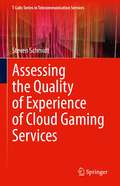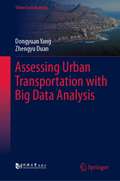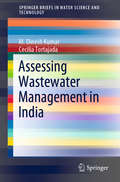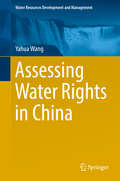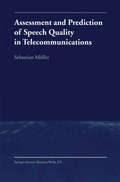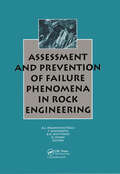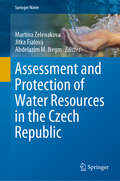- Table View
- List View
Assessing the Quality of Experience of Cloud Gaming Services (T-Labs Series in Telecommunication Services)
by Steven SchmidtThis book provides an overview of concepts and challenges in intis investigated using structural equation modeling. The conveyed understanding of gaming QoE, empirical eraction quality in the domain of cloud gaming services. The author presents a unified evaluation approach by combining quantitative subjective assessment methods in a concise way. The author discusses a measurement tool, Gaming Input Quality Scale (GIPS), that assesses the interaction quality of such a service available. Furthermore, the author discusses a new framework to assess gaming Quality of Experience (QoE) using a crowdsourcing approach. Lastly, based on a large dataset including dominant network and encoding conditions, the evaluation method is investigated using structural equation modeling. The conveyed understanding of gaming QoE, empirical findings, and models presented in this book should be of particular interest to researchers working in the fields of quality and usability engineering, as well as service providers and network operators.
Assessing the Risks of Nuclear and Chemical Contamination in the former Soviet Union (NATO Science Partnership Subseries: 2 #10)
by Elizabeth J. KirkRisk assessment has come to assume acute importance in the former Soviet Union since money is so scarce, yet the needs for cleanup are so huge. Other factors contribute to this situation, too: New leaders are still emerging, and governmental structures are still evolving. This creates a particular difficulty for environmentalists who attempt to become involved in the risk assessment process. New information continues to surface on the fallout from Chernobyl and its consequences for human health. Scientists are still debating the effects of low doses of radiation delivered over a long period of time. This type of contamination is especially prevalent in the Russian North, for example, as a result of the dumping of nuclear submarine reactors into the Kara and Barents Seas. This book examines the complexities of risk assessment in the FSU at this unique time in history.
Assessing Urban Transportation with Big Data Analysis (Urban Sustainability)
by Dongyuan Yang Zhengyu DuanThis book chiefly focuses on urban traffic, an area supported by massive amounts of data. The application of big data to urban traffic provides strategic and technical methods for the multi-directional and in-depth observation of complex adaptive systems, thus transforming conventional urban traffic planning and management methods. Sharing valuable insights into how big data can be applied to urban traffic, it offers a valuable asset for information technicians, traffic engineers and traffic data analysts alike.
Assessing Wastewater Management in India (SpringerBriefs in Water Science and Technology)
by M. Dinesh Kumar Cecilia TortajadaThis book highlights the institutional, legal, and policy measures to manage water pollution in India, and discusses how effective they have been in improving the overall quality of the country’s surface and groundwater resources. It also reviews the status of wastewater generation, collection and treatment in urban areas to provide insights into the gaps in wastewater treatment. Further, it offers a detailed analysis of the wastewater treatment systems available and examines the human health impacts of water pollution in the country, as well as the future trajectory of investment in wastewater treatment systems and potential sectors for reuse and recycling of wastewater, briefly assessing the market demand for treated wastewater. Lastly, it investigates the factors influencing the environmental sustainability and economic viability of wastewater treatment as well as future areas of research in the field.
Assessing Water Rights in China (Water Resources Development and Management)
by Yahua WangThis book presents a model for describing the hierarchical concept of China’s water rights structure, one which takes into account pioneering theories on natural resources and environmental institutional economics. It highlights the basic theory of water rights, with a view to helping Chinese policymakers acquire a deeper understanding of water rights and the need for a reform program in the long-term development of water-poor China. To do so, it draws on three main sources: Cheung SNS’s “Economic Explanation”, Douglas C. North’s “New Economic History” and Ray Huang’s “Macro History”.The book makes two essential contributions: it elaborates the hierarchical water governance structure in China, which originated in the Qin Dynasty that unified the country 2000 years ago and has been employed without interruption ever since; further, it constructs a choice model for water governance structures and advances the logic of making structural choices with minimum transaction costs under constraint conditions, while also explaining the inherent nature of China’s choice for the hierarchical structure from the perspectives of management cost and cooperation cost. As such, the book enriches and builds on the theories of the “water governance” school represented by Karl Marx, Karl Wittfogel and Ray Huang, laying the foundation for the further study of water rights theory in contemporary China.
Assessment and Future Directions of Nonlinear Model Predictive Control (Lecture Notes in Control and Information Sciences #358)
by Rolf Findeisen Frank Allgöwer Lorenz BieglerThepastthree decadeshaveseenrapiddevelopmentin the areaofmodelpred- tive control with respect to both theoretical and application aspects. Over these 30 years, model predictive control for linear systems has been widely applied, especially in the area of process control. However, today’s applications often require driving the process over a wide region and close to the boundaries of - erability, while satisfying constraints and achieving near-optimal performance. Consequently, the application of linear control methods does not always lead to satisfactory performance, and here nonlinear methods must be employed. This is one of the reasons why nonlinear model predictive control (NMPC) has - joyed signi?cant attention over the past years,with a number of recent advances on both the theoretical and application frontier. Additionally, the widespread availability and steadily increasing power of today’s computers, as well as the development of specially tailored numerical solution methods for NMPC, bring thepracticalapplicabilityofNMPCwithinreachevenforveryfastsystems.This has led to a series of new, exciting developments, along with new challenges in the area of NMPC.
Assessment and Management of Environmental Risks: Cost-efficient Methods and Applications (NATO Science Series: IV: #4)
by JosePalma-Oliveira IgorLinkovManaging environmental contamination requires decision makers to weigh eXlstmg risks against the potential effects of implementing environmental policies - considering both the benefits and disruptions that may result from different actions. The NATO Advanced Research Workshop in Lisbon was an important step in the development and application of cost efficient methods of risk assessment especiaIly within the constraints of a budget. The goal of the workshop was to evaluate the potential for risk assessment to serve as a unified and unifying technique in addressing a wide range of environmental problems. Papers presented in this book discuss issues ranging from specific and local studies (specific site, ecosystem, pollutant) to global decision and management frameworks (watersheds, regions, integration of multiple poIlutants and stressors); they develop a range of approaches starting from specific methods to widely applied public policies (Figure 1). The papers show that the use of risk assessment can provide the scientific basis for environmentaIly sound and cost-efficient policies, strategies, and solutions to our environmental chaIlenges. The organization of the Proceedings reflects sessions and discussions during the workshop. The papers in the introductory Chapter summarize the positions of Drs. Glenn Suter (EPA) and Jim Wilson (Resources for the Future) regarding whether the use of often-expensive risk assessments in developing countries can be justified, given evolving regulatory institutions and limited resources.
Assessment and Management of Plant Invasions (Springer Series on Environmental Management)
by James O. Luken John W. ThieretBiological invasion of native plant communities is a high-priority problem in the field of environmental management. Resource managers, biologists, and all those involved in plant communities must consider ecological interactions when assessing both the effects of plant invasion and the long-term effects of management. Sections of the book cover human perceptions of invading plants, assessment of ecological interactions, direct management, and regulation and advocacy. It also includes an appendix with descriptive data for many of the worst weeds.
Assessment and Prediction of Speech Quality in Telecommunications
by Sebastian MöllerThe quality of a telecommunication voice service is largely inftuenced by the quality of the transmission system. Nevertheless, the analysis, synthesis and prediction of quality should take into account its multidimensional aspects. Quality can be regarded as a point where the perceived characteristics and the desired or expected ones meet. A schematic is presented which classifies different entities which contribute to the quality of a service, taking into account conversational, user as weIl as service related contributions. Starting from this concept, perceptively relevant constituents of speech communication quality are identified. The perceptive factors result from ele ments of the transmission configuration. A simulation model is developed and implemented which allows the most relevant parameters of traditional trans mission configurations to be manipulated, in real time and for the conversation situation. Inputs into the simulation are instrumentally measurable quality elements commonly used in transmission planning of telephone networks. A reduced set of these quality elements forms a basis for models which aim at predicting mouth-to-ear quality as it would be perceived by a user of the sys tem. These models are an important tool for the planner of telecommunication networks, as they allow the expected quality to be estimated in advance, even before the network has been set up. Two well-known models (the SUBMOD and the E-model) are analyzed in more detail, with an emphasis on the psy choacoustic and psychophysical backgrounds.
Assessment and Prevention of Failure Phenomena in Rock Engineering
by O. Aydan A. G. Pasamehmetoglu T. Kawamoto B. N. WhittakerFirst published in 1993. This volume is a collection of papers addressing the issue of the failure of rock engineering structures. This phenomenon occurs in different forms depending on the geometry of structure, material properties of intact rock, structure of rock mass, environmental conditions and initial state of stress.
Assessment and Protection of Water Resources in the Czech Republic (Springer Water)
by Martina Zelenakova Jitka Fialová Abdelazim M. NegmThis book gathers technical and scientific contributions from leading researchers, academics, and lecturers, focusing on water management, water pollution and water structures in the Czech Republic. It discusses a variety of water resources management issues, from stormwater management in urban areas, water quantity, hydraulics structures and hydrodynamic modeling, to flood protection, presenting state-of-the-art developments for addressing a range of problems. Edited and authored by pioneers in the field who have been at the cutting edge of water management development in the Czech Republic, this book is of interest to environmental professionals, including scientists and policymakers both in the Czech Republic and around the globe.
Assessment and Remediation of Contaminated Sediments (Nato Science Series: IV: #73)
by Danny Reible Tomas LanczosIn this text, drawn from presentations and discussion at a May 2005 NATO Advanced Research Workshop, current approaches to the assessment and remediation of contaminated sediments are discussed with emphasis on in-situ management. The text addresses physical, chemical and biological approaches for the assessment and remediation of sediments. The development of regulatory and strategic approaches is discussed with emphasis on the potential for biological remediation in the management of contaminated sediments.
Assessment and Remediation of Petroleum Contaminated Sites
by G. Mattney ColeFederal regulations have required thousands of underground storage tanks (USTs) to be dug up and removed or replaced. The contamination of soil and ground water from leaking USTs has become widespread and has produced an overwhelming number of sites that require remediation. Assessment and Remediation of Petroleum Contaminated Sites presents the broad scope of the remedial process from initial site assessment to closure in an integrated, understandable format. The book guides you effortlessly through regulatory requirements, site assessments and sampling, and remediation methods. RCRA and CERCLA federal regulations are addressed. The chemistry and toxicology of petroleum hydrocarbons in the remediation process are explained, and factors affecting soil remediation are discussed. Environmental assessments, site characterizations, remediation planning, and remediation methods are all covered in detail. The book is an essential guide for environmental consultants, regulatory agency personnel, engineers, and environmental attorneys.
Assessment and Remediation of Petroleum Contaminated Sites
by G. Mattney ColeFederal regulations have required thousands of underground storage tanks (USTs) to be dug up and removed or replaced. The contamination of soil and ground water from leaking USTs has become widespread and has produced an overwhelming number of sites that require remediation. Assessment and Remediation of Petroleum Contaminated Sites presents the broad scope of the remedial process from initial site assessment to closure in an integrated, understandable format. The book guides you effortlessly through regulatory requirements, site assessments and sampling, and remediation methods. RCRA and CERCLA federal regulations are addressed. The chemistry and toxicology of petroleum hydrocarbons in the remediation process are explained, and factors affecting soil remediation are discussed. Environmental assessments, site characterizations, remediation planning, and remediation methods are all covered in detail. The book is an essential guide for environmental consultants, regulatory agency personnel, engineers, and environmental attorneys.
Assessment and Simulation Tools for Sustainable Energy Systems: Theory and Applications (Green Energy and Technology #129)
by Fausto CavallaroIn recent years, the concept of energy has been revised and a new model based on the principle of sustainability has become more and more pervasive. The appraisal of energy technologies and projects is complex and uncertain as the related decision making has to encompass environmental, technical, economic and social factors and information sources. The scientific procedure of assessment has a vital role as it can supply the right tools to evaluate the actual situation and make realistic forecasts of the effects and outcomes of any actions undertaken. Assessment and Simulation Tools for Sustainable Energy Systems offers reviews of the main assessment and simulation methods used for effective energy assessment. Divided across three sections, Assessment and Simulation Tools for Sustainable Energy Systems develops the reader’s ability to select suitable tools to support decision making and implementation of sustainable energy projects. The first is dedicated to the analysis of theoretical foundations and applications of multi-criteria decision making. This is followed by chapters concentrating on the theory and practice of fuzzy inference, neural nets and algorithms genetics. Finally, simulation methods such as Monte Carlo analysis, mathematical programming and others are detailed. This comprehensive illustration of these tools and their application makes Assessment and Simulation Tools for Sustainable Energy Systems a key guide for researchers, scientists, managers, politicians and industry professionals developing the field of sustainable energy systems. It may also prompt further advancements in soft computing and simulation issues for students and researchers.
Assessment and Teaching of 21st Century Skills: Research and Applications (Educational Assessment in an Information Age)
by Esther Care Patrick Griffin Mark WilsonThis book provides a detailed description of research and application outcomes from the Assessment and Teaching of 21st Century Skills project, which explored a framework for understanding the nature of these skills. The major element of this new volume is the presentation of research information from the global assessment of two 21st century skills that are amenable to teaching and learning: collaborative problem solving, and learning in digital networks. The outcomes presented include evidence to support the validity of assessment of 21st century skills and descriptions of consequent pedagogical approaches which can be used both to teach the skills and to use them to enhance key learning goals in secondary education systems. The sections of the volume are connected through a focus on the degree to which innovative assessment tasks measure the constructs of interest. This focus is informed by conceptual and methodological issues associated with affordances of 21st century computer-based assessment. How understanding of the nature of the skills, as derived from these assessments, can guide approaches to the integration of 21st century skills in the classroom, is informed by initiatives adopted by participating countries. The guiding questions in this volume are: "Do the assessment tasks measure the constructs?" and "What are the implications for assessment and teaching in the classroom?" It is the third volume of papers from this project published by Springer.
Assessment and Teaching of 21st Century Skills (Educational Assessment in an Information Age)
by Patrick Griffin, Barry McGaw and Esther CareRapid—and seemingly accelerating—changes in the economies of developed nations are having a proportional effect on the skill sets required of workers in many new jobs. Work environments are often technology-heavy, while problems are frequently ill-defined and tackled by multidisciplinary teams. This book contains insights based on research conducted as part of a major international project supported by Cisco, Intel and Microsoft. It faces these new working environments head-on, delineating new ways of thinking about ‘21st-century’ skills and including operational definitions of those skills. The authors focus too on fresh approaches to educational assessment, and present methodological and technological solutions to the barriers that hinder ICT-based assessments of these skills, whether in large-scale surveys or classrooms. Equally committed to defining its terms and providing practical solutions, and including international perspectives and comparative evaluations of assessment methodology and policy, this volume tackles an issue at the top of most educationalists’ agendas.
Assessment, Evaluation, and Repair of Concrete, Steel, and Offshore Structures
by Mohamed Abdallah El-ReedyCivil engineers must assure that buildings have long and durable lives, and therefore structural assessment and repair are routinely required and must be performed with the utmost accuracy and professionalism. Assessment, Evaluation, and Repair of Concrete, Steel, and Offshore Structures presents the typical causes of structural failure and their mechanisms, discusses the most up-to-date methods for evaluation and structural assessment, and explains the best project management strategies from the feasibility stage through operations and maintenance. Numerous types of structures are examined and are further illustrated by relevant case studies. Features: Examines the probability of several types of structural failure and includes reliability analysis. Presents best practices for predicting the structural lifetime for both onshore and offshore structures and reviews the most advanced methods for repair. Includes numerous practical case studies of structural failure and offers mitigation strategies depending of type of structure.
Assessment, Evaluation, and Repair of Concrete, Steel, and Offshore Structures
by Mohamed Abdallah El-ReedyCivil engineers must assure that buildings have long and durable lives, and therefore structural assessment and repair are routinely required and must be performed with the utmost accuracy and professionalism. Assessment, Evaluation, and Repair of Concrete, Steel, and Offshore Structures presents the typical causes of structural failure and their mechanisms, discusses the most up-to-date methods for evaluation and structural assessment, and explains the best project management strategies from the feasibility stage through operations and maintenance. Numerous types of structures are examined and are further illustrated by relevant case studies. Features: Examines the probability of several types of structural failure and includes reliability analysis. Presents best practices for predicting the structural lifetime for both onshore and offshore structures and reviews the most advanced methods for repair. Includes numerous practical case studies of structural failure and offers mitigation strategies depending of type of structure.
Assessment in Game-Based Learning: Foundations, Innovations, and Perspectives
by Dirk Ifenthaler, Deniz Eseryel and Xun GeThe capabilities and possibilities of emerging game-based learning technologies bring about a new perspective of learning and instruction. This, in turn, necessitates alternative ways to assess the kinds of learning that is taking place in the virtual worlds or informal settings. accordingly, aligning learning and assessment is the core for creating a favorable and effective learning environment. The edited volume will cover the current state of research, methodology, assessment, and technology of game-based learning. There will be contributions from international distinguished researchers which will present innovative work in the areas of educational psychology, educational diagnostics, educational technology, and learning sciences. The edited volume will be divided into four major parts.
Assessment of Biodiversity for Improved Forest Planning (Forestry Sciences #51)
by Peter BachmannThe `Global Biodiversity Strategy' signed in 1992 in Rio de Janeiro, and the resolutions at the Ministerial Conferences on the Protection of Forests in Europe in Strasbourg, 1990, and Helsinki, 1993, commit the signatory states to monitor nationally the state of biodiversity and to sustain the characteristic natural variation in the country. Sustainability and long-term planning are the two terms best describing the philosophy of traditional forest management practices. However, the traditional planning techniques are not primarily developed to maintain sustainability of biodiversity. The gap between the international commitments and the practices in forest assessment and management is obvious. This publication presents experience in methodology for assessing and monitoring the variation of ecosystems and habitats in relation to biodiversity conservation and for integrating biodiversity in regional planning of forest management and land use. The state of the art in the field of natural resource assessments with special reference to forest biodiversity is reviewed, progress in integrating data on biodiversity in forest management planning is presented and the information needs regarding biodiversity conservation and the question to what degree assessment methods for forest biodiversity can be simplified for practical applications are discussed. The book is intended for researchers and practitioners in the field of forest and environmental planning and environmental policies.
Assessment of Carbon Footprint in Different Industrial Sectors, Volume 1 (EcoProduction)
by Subramanian Senthilkannan MuthuCarbon footprint is one of the important environmental impacts, which has received greater attention from the public, government and media. It is one of the important topics of even any government’s agenda as well and every nation is trying its best to reduce its carbon footprint to the maximum possible extent. Every company would like to reduce the carbon footprint of its products and consumers are looking for the products which emit lower carbon emissions in their entire life cycle. Assessment of Carbon footprint for different products, processes and services and also carbon labelling of products have become familiar topics in the recent past in various industrial sectors. Every industry has its unique assessment and modelling techniques, allocation procedures, mitigation methods and labelling strategies for its carbon emissions. With this background, this book has been framed with dedicated chapters on carbon footprint assessment on various industrial sectors. In each chapter, details pertaining to the assessment methodologies of carbon footprint followed in a particular industry, challenges in calculating the carbon footprint, case studies of various products in that particular industry, mitigation measures to be followed to trim down the carbon footprint, recommendations for further research are discussed in detail. This first volume includes the carbon footprint assessment methodology of agricultural sector, telecommunication sector, food sector, ceramic industry, packaging industry, building and construction sector and solid waste sector.
Assessment of Carbon Footprint in Different Industrial Sectors, Volume 2 (EcoProduction)
by Subramanian Senthilkannan MuthuFollowed by the previous part (Volume-1), Volume-2 of carbon footprint assessment book deals with the assessment of carbon footprint in different other sectors, which were not dealt in the first part. Attention on Carbon footprint is growing day-by-day from the public, government and media. Certainly it is one of the most important topics in the agenda of every nation, which is trying its best to reduce its carbon footprint to the maximum possible extent. Every manufacturing industry or sector would like to reduce the carbon footprint of its products and consumers are looking for the products which emit lower carbon emissions in their entire life cycle. Assessment of Carbon footprint for different products, processes and services and also carbon labeling of products have become familiar topics in the recent past in various industrial sectors. Every industry has its unique assessment and modeling techniques, allocation procedures, mitigation methods and labeling strategies for its carbon emissions. With this background, volume two of this book has been framed with dedicated chapters on carbon footprint assessment on various industrial sectors, apart from the ones covered in Volume 1. In each chapter, details pertaining to the assessment methodologies of carbon footprint followed in a particular industry, challenges in calculating the carbon footprint, case studies of various products in that particular industry, mitigation measures to be followed to trim down the carbon footprint, recommendations for further research are discussed in detail.
Assessment of Chemical Exposures: Calculation Methods for Environmental Professionals
by Jack E. DaughertyTraditionally, industrial hygienists and environmental engineers have been responsible for conducting chemical exposure assessments, however, this task is now becoming a team effort taken on by scientists, businessmen, and policymakers. Assessment of Chemical Exposures: Calculation Methods for Environmental Professionals addresses the expanding scope of exposure assessments in both the workplace and environment. It discusses the basics of gathering data and assessing exposure, including how to estimate exposure to chemicals using fundamental chemical engineering concepts. The book opens with a brief discussion on the history of exposure assessments and provides terms and nomenclature needed for communications between various disciplines involved in exposure assessments. The potential impact of chemical exposures on humans, the environment, and communities is discussed in detail The book also addresses modeling source generation, pathway transport, and receptor impact. With the clear explanations presented in this text, even a novice will be able to practice the art of exposure assessment.
Assessment of Chemical Exposures: Calculation Methods for Environmental Professionals
by Jack E. DaughertyTraditionally, industrial hygienists and environmental engineers have been responsible for conducting chemical exposure assessments, however, this task is now becoming a team effort taken on by scientists, businessmen, and policymakers. Assessment of Chemical Exposures: Calculation Methods for Environmental Professionals addresses the expanding scope of exposure assessments in both the workplace and environment. It discusses the basics of gathering data and assessing exposure, including how to estimate exposure to chemicals using fundamental chemical engineering concepts. The book opens with a brief discussion on the history of exposure assessments and provides terms and nomenclature needed for communications between various disciplines involved in exposure assessments. The potential impact of chemical exposures on humans, the environment, and communities is discussed in detail The book also addresses modeling source generation, pathway transport, and receptor impact. With the clear explanations presented in this text, even a novice will be able to practice the art of exposure assessment.
